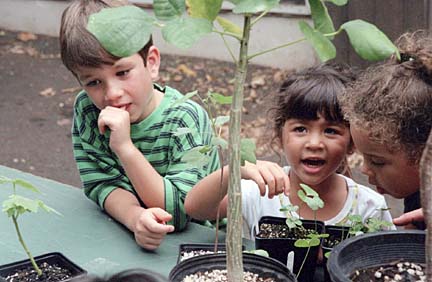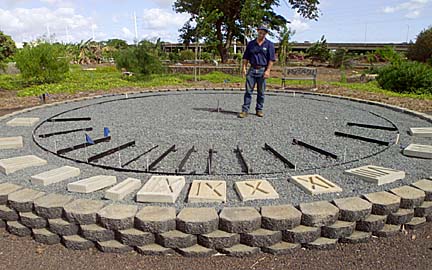


In The Garden![]()
Friday, July 20, 2001

CRAIG T. KOJIMA / CKOJIMA@STARBULLETIN.COM
Greg Koob works with children at Foster Gardens.
If only there were plants bearing fruits of cheese and pepperoni, the Pizza Garden at the Urban Garden Center in Pearl City would actually smell like a real pizza. It already has tomatoes, green bell peppers, onions, parsley, basil and sweet marjoram, each with a sweet scent suggesting lunch. There's also a sprinkling of pineapple plants for a tropical flavor. The power of gardens
A UH project in Pearl City is
using themed gardens to teach kids
nutrition, geography and moreTo complete the pizza, Steve Nagano, the garden's architect, had to make do with two substitutes. To represent cheese, he planted swan daisy for the bright yellow flowers. His volunteer helper Tom Nakasone cut up a fallen tree and painted the slices of wood red to make mock pepperoni.
"We can't have real pepperoni and cheese in the garden, but children can use their imagination and have a good time in the garden anyway," Nagano said.
The Pizza Garden is a tool to teach children more than just plants and gardening. It also can teach children about fractions, geography and nutrition.

The Pizza Garden, about 15 feet in diameter, is divided into eight slices, and one slice is deliberately left barren to help children understand portions. Kids learn about geography by discovering in which part of the world pizza originated.A docent-led tour includes a lesson on nutrition based on various ingredients in the pizza. The emphasis is on eating healthy. Vegetable toppings, of course, are the most healthful. But pepperoni and cheese seem to be the most popular. (An informal survey of three pizza outlets resulted in pepperoni and cheese as the most favored toppings.)
The Pizza Garden is one of several theme gardens in the master plan for a Children's Garden at the 31-acre facility owned by the University of Hawaii. Other parts of the Children's Garden include the Hawaiian Alphabet Tree Garden, the Animal Garden, the Sundial/Compass Garden and the Sensory Garden, for the blind and physically handicapped. Plans are being drawn for a Seasonal Garden, which would have alternating plants to mark seasonal celebrations and holidays, and a House Garden, for plants with the names of household items.

The Hawaiian Alphabet Tree Garden is planted with Hawaiian trees whose names begin with a letter of the Hawaiian alphabet. The trees, planted about a year ago, have taken off except for the sandalwood tree, which remains a scraggly 6-inch seedling.The Animal Garden consists of plants with the names of animals, such as the zebra plant, leopard tree and fishtail fern. The plants are organized not according to their natural habitat, but to what kinds of animals are in their names. Those with marine animals are planted together, while those with insect names are grouped together elsewhere.
"We try to make it interesting for the kids. We try to have themes within themes in the garden, like dog chasing cat, cat chasing mice. We planted the dog bone tree next to the cat's tail. Then there are the cat's whiskers, and that's next to the catnip. And then comes the Mickey Mouse plant," Nagano said.
The centerpiece in the Animal Garden is a 10-foot giraffe topiary made out of steel and wire mesh. The garden volunteers filled it with moss, and ivy plants are slowly growing in.
The Sundial/Compass Garden is being built and when completed will have plants meant to teach children about directions, time and science.

The Sensory Garden, also under construction, is to be contained on two large raised beds to allow easier access for the handicapped. The beds are waist high and are ready to be planted with plants that have interesting textures and fragrances.The Children's Garden is not completed, but it is open for viewing. Visitors may choose self-guided tours or call ahead to book for docent-led tours. A minimum of 10 people is required for docent-led tours.
The Urban Garden Center includes other types of plant groupings for viewing: hibiscus, taro, plumeria, ground covers, herbs, to name a few. The center encourages tours in the morning, when it is cool. The tours are free. Call 453-6050.
The center also seeks volunteers to work in the garden and for training as docents.
Where: 962 Second St. Self-guided tours: 9 a.m. to noon, first Saturday of month. Group tours for 10 or more, Monday and Tuesday mornings Urban Garden Center
Call: 453-6050
Gardening Calendar
Suzanne Tswei's gardening column runs Saturdays in Today.
You can write her at the Star-Bulletin,
500 Ala Moana, Suite 7-210, Honolulu, HI, 96813
or email stswei@starbulletin.com